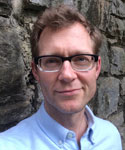Things on my desk: computer, books, coffee mug.
I regard them and wonder: Is it possible that looking at these things could bring life? Could examining the details of a simple letterhead or computer mouse bring a moment to pause, acknowledge, thank and bless?
Mindfulness -- staying present in the moment -- is currently popular as a way to relieve stress and help us pay attention. But this practice is not new.
The capacity to be present enough to turn outward is a wondrous capacity, and our current pursuit of it has fascinating historical counterparts. In the 19th century, scientists and artists were preoccupied with noticing things.
In the book “The Invention of Nature,” Andrea Wulf chronicles the adventures of Alexander von Humboldt, an explorer and scientist with a passion for learning about the natural world.
Humboldt’s work profoundly influenced 19th-century thought, for he kept widening the European eye to the rest of the world with observations on specimens, mountains, rain forests and climates. Much of his work reads like a deep celebration of facts: how titi monkeys swing, the bright blue of the crayfish, the volts of electric eels, how different rivers in the Llanos and the Orinoco taste.
Humboldt traveled with trunks for plants and insects, notebooks full of drawings and measurements, telescopes, microscopes, thermometers and other instruments for recording what he and his unflagging team found.
How astonishing it would have been to receive the packages he sent home: leaves, stones, ores, spiders, feathers and petals, all expanding one’s idea of the world, the variations and prismatic colors in it.
This was a science of particulars, and the way to master it was through details -- or more specifically, looking at the details.
Noticing and naming the color of the monkey fur, how the grain of the feathers runs, the exact height of the palm tree -- these things were vitally important, and though reflection may follow (Humboldt had prescient things to say about the interdependence of ecosystems), the thrust of his scientific curiosity was a hunger for the sacredness of fact.
This practice of looking at things fused aesthetic responsibility with spiritual weight. The English writer and artist John Ruskin wrote that “men usually see little of what is before their eyes”; “the truth of nature is a part of the truth of God; to him who does not search it out, darkness, as it is to him who does, infinity.”
Gerard Manley Hopkins, one of the great Christian poets, was shaped by Ruskin’s thought. Hopkins’ poems, journals and sermons resound with the very act of looking. These lines from “Pied Beauty” read like a nature guide for a country walk:
Glory be to God for dappled things --
For skies of couple-colour as the brinded cow;
For rose-moles all in stipple upon trout that swim;
Fresh-firecoal chestnut-falls; finches’ wings … (lines 1-4)
Throughout Hopkins’ journals are drawings and passages that push to capture the things he is looking at. Like Humboldt and Ruskin, Hopkins would examine the exact way the clouds gathered around the hills, the exact movement of water’s flow around rocks.
But what is the point of all this exactitude? Of looking with such intent?
There is humility. The time it takes for someone to actually observe something -- to notice the color, shape, shadow, texture -- carves out a space in his or her own being for the reality of something else. The emphasis shifts from self to an item made by someone else.
There is quietness and slowness. Examining a single leaf, asking questions of its form, seeking to name its individualizing details -- this kind of looking prompts an intent that quiets the mind from its busy spinning wheels.
And of course, there is gratitude. It is hard to inspect things with such attention without experiencing wonder that they exist in all their intricate detail, and thankfulness for the deep patterns unfolding all around.
But what about the interiors of the working world? Many of us don’t have country walks at our disposal -- what of items on a desk? Files, paperwork, pen, computer mouse, coffee mug with lukewarm coffee and powdered creamer. Is there anything here to look at?
I think there is. Ruskin wrote in “Modern Painters” that “to find even in all that appears most trifling or contemptible, fresh evidence of the constant working of the Divine power ‘for glory and for beauty,’ and to teach it and proclaim it” is the “peculiar province” of the artist.
This could very well be the province of someone in the Christian faith, too. Doesn’t grace help us find worth in what is often overlooked?
Our workspaces can become like whirlpools -- personnel issues, budgets, deadlines, drafts, revisions, emails, projects, memos, meetings -- all swirling around, needing attention.
In the midst of this, the practice of looking at things can become a holy practice.
It might be walking at lunch to marvel at the natural world. It might be inspecting an orange before peeling and eating it, or looking at someone’s handwriting before reading the note. The turn outward, the focus on something else, yields the gracious space to connect with the “fresh evidence” of God’s handiwork.












